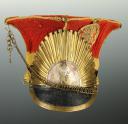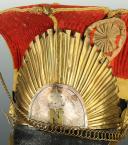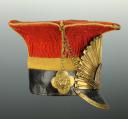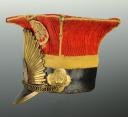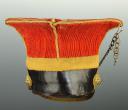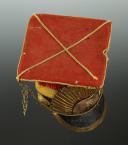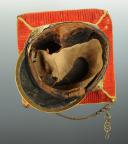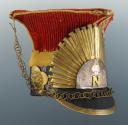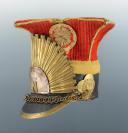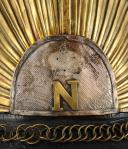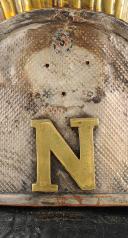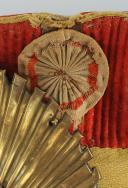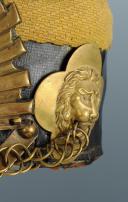
CZAPSKA DUTCH LANCER TROUP, FIRST EMPIRE (1810-1815).
Sold out
CZAPSKA DUTCH LANCER TROUP, FIRST EMPIRE (1810-1815).
Czapska 24 cm high at the front, 22 cm at the sides and 19 cm at the back. The width of its upper part, flat and square, is 24.5 cm.
Turban 9 cm high, topped with ribbed scarlet cloth (H approximately 12 cm without counting the curve, H approximately 13 cm including the curve). The meeting of the leather and the cloth is hidden by a braid of yellow thread 3.5 cm wide and covers it halfway.
The four sides of the czapska are trimmed with a yellow braid, called soutache, which meets in a cross on top.
Each of the top corners is garnished with a brass fleuron (the rear fleuron is missing). The right finial supports a hook intended to raise the chinstrap if necessary.
On each side of the czapska is placed a rosette in the shape of a lion's head in brass stamped in relief on quatrefoil; from the one on the left, there is a brass curb chain forming the chin strap (length 45 cm); this chinstrap is lined with scarlet cloth (now missing), at its other end, a suspension hook is attached; on the lion's head on the opposite side, a brass hook is intended to support the chain.
Patent leather visor, slightly inclined and bordered by a brass bangle placed astride the outer border with an apparent width of 1.2 cm. Width of the visor at its center 7 cm.
Roundel woven in tricolor wool, sewn on the left bell (diameter 7.2 cm) over the leather sheath intended for the plume.
On the front, a plaque (H 15.5 cm, width 24 cm) is fixed in brass with rays stamped in relief, with a center in silver-plated copper (H 7 cm, width 10 cm) decorated with an “N” (H 2.5 cm, width 2.4 cm) in brass originally topped with a missing crown.
The inside of the czapska is lined with a preparation of cardboard and oilcloth; each side of the faces is supported on a stick of rush.
Inner headdress composed of a black waxed leather headband 6 cm high topped with a beige canvas headdress 8 cm high.
Very good state.
France.
First Empire (1810-1815).
NOTE :
The 1st regiment of Dutch Hussars was abolished by decree of the King of Holland of June 16, 1810. It was to be united with the regiment of the horse guard, when the imperial decree of September 13 incorporated the Dutch royal guard into the imperial guard. The Hussars regiment was then to form the 2nd Chevau-légers Lancers regiment of the Imperial Guard, better known as the Red Lancers. This illustrious regiment will participate in the great campaigns of the Empire.
Very few authentic hairstyles have come down to us, probably less than fifteen.
Czapska 24 cm high at the front, 22 cm at the sides and 19 cm at the back. The width of its upper part, flat and square, is 24.5 cm.
Turban 9 cm high, topped with ribbed scarlet cloth (H approximately 12 cm without counting the curve, H approximately 13 cm including the curve). The meeting of the leather and the cloth is hidden by a braid of yellow thread 3.5 cm wide and covers it halfway.
The four sides of the czapska are trimmed with a yellow braid, called soutache, which meets in a cross on top.
Each of the top corners is garnished with a brass fleuron (the rear fleuron is missing). The right finial supports a hook intended to raise the chinstrap if necessary.
On each side of the czapska is placed a rosette in the shape of a lion's head in brass stamped in relief on quatrefoil; from the one on the left, there is a brass curb chain forming the chin strap (length 45 cm); this chinstrap is lined with scarlet cloth (now missing), at its other end, a suspension hook is attached; on the lion's head on the opposite side, a brass hook is intended to support the chain.
Patent leather visor, slightly inclined and bordered by a brass bangle placed astride the outer border with an apparent width of 1.2 cm. Width of the visor at its center 7 cm.
Roundel woven in tricolor wool, sewn on the left bell (diameter 7.2 cm) over the leather sheath intended for the plume.
On the front, a plaque (H 15.5 cm, width 24 cm) is fixed in brass with rays stamped in relief, with a center in silver-plated copper (H 7 cm, width 10 cm) decorated with an “N” (H 2.5 cm, width 2.4 cm) in brass originally topped with a missing crown.
The inside of the czapska is lined with a preparation of cardboard and oilcloth; each side of the faces is supported on a stick of rush.
Inner headdress composed of a black waxed leather headband 6 cm high topped with a beige canvas headdress 8 cm high.
Very good state.
France.
First Empire (1810-1815).
NOTE :
The 1st regiment of Dutch Hussars was abolished by decree of the King of Holland of June 16, 1810. It was to be united with the regiment of the horse guard, when the imperial decree of September 13 incorporated the Dutch royal guard into the imperial guard. The Hussars regiment was then to form the 2nd Chevau-légers Lancers regiment of the Imperial Guard, better known as the Red Lancers. This illustrious regiment will participate in the great campaigns of the Empire.
Very few authentic hairstyles have come down to us, probably less than fifteen.
Reference :
209
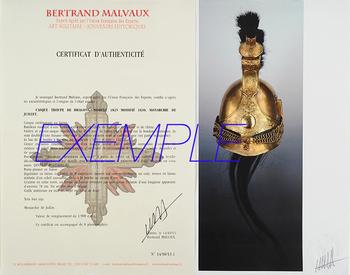
Next update Friday, april 4th at 1:30 PM
FOR ALL PURCHASES, PAYMENT IN MULTIPLE CHECKS POSSIBLE
bertrand.malvaux@wanadoo.fr 06 07 75 74 63
An authenticity certificate of the item including the description published on the site, the period, the sale price, accompanied by one or more color photographs is automatically provided for any item priced over 130 euros. Below this price, each certificate is charged 5 euros.
Only items sold by me are subject to an authenticity certificate, I do not provide any expert reports for items sold by third parties (colleagues or collectors).
